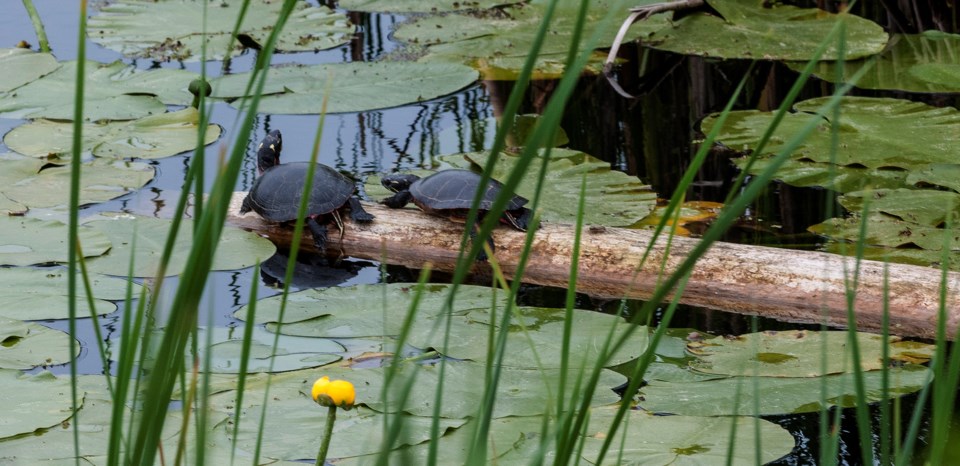Over the past few years you may have (should have) noticed new roadside signs being installed that indicate the area is used by turtles to cross the road from one side to the other. The reason behind these postings is to ensure drivers become alert to the probable presence of pedestrian turtles and will slow down and avoid hitting them.
Unfortunately, some drivers seem to have taken the notion that these signs indicate a target range and will go out of their way (and lane) to smack a turtle or two. Gross and appalling, but it's happening.
The background to these turtle crossing signs is that turtle populations are in decline. And why are they disappearing? The answer is roads. New roads. Paved roads. Busy roads. Roads that transect a wetland and have lovely gravel shoulders. Roads are a death warrant for turtles.
So what makes a road so irresistible to a turtle? Two things, one moreso than the other. The minor reason is that black pavement absorbs heat from bright sunlight and retains that heat for a while after the sun goes down. Turtles and frogs desire heat to warm their bodies, especially on a chilly spring day. And so they get lulled into thinking they have just found the world's biggest basking site, and then wham.
The greater reason for turtle mortality on roadways is that the gravel shoulders make perfect egg-laying sites for these prehistoric critters. A shallow vase-shaped hole is dug, eggs are dropped inside, the gravel is raked back over the hole and mother turtle departs, leaving the nest to be incubated by the sun's solar energy.
Why turtles have to build their nest on the opposite side of the road from where they depart the swamp is a mystery to me. I understand that several university studies have been done on this nesting situation, trying to determine if the nest location is selected due to alignment to the sun, or distance from the water, or quality of gravel. Whatever the answer is, turtles are using these roadsides with wild abandon.
Up next on the list of perils that a turtle faces is predators, such as raccoons, skunks, foxes, gulls and crows. An adult turtle is very hard to kill and eat, but eggs and baby turtles are soft and easy to attain. The mammals just walk along a road and dig up the nests. The birds fly by these long open stretches and pick off the wee ones as they emerge from the nest later in the year.
To sum up so far, turtles replenish their population by laying lots of eggs, knowing (somehow) that several will become breakfast for natural predators. In the natural scheme of things, over the past many eons of time, this has balanced out enough to ensure turtles had enough survivors to carry on. But nowadays the scale of survival has been tipped out of whack.
While roads have created more nest building habitat, their very presence has put the mother turtles at peril. Paved roads are warm and the vehicle traffic is fast. And as raccoons, skunks and foxes have adapted to human activities the roadsides are walkways between garbage cans and other yummy debris.
Last point: if a baby turtle survives the nest robbing, if it survives the road crossing and makes in to the security of the swamp, it will be about ten years before it matures to reproduce. While it's waiting around the find a mate, the slaughter continues, indeed increases, on the nearby road. The overall result being fewer and fewer turtles.
Which is why the Midland painted turtle has just been added to the growing list of species at risk in Ontario. A couple years ago snapping turtles were added, and research indicates painted turtles need to join the list of imperiled wildlife. The designation is Special Concern. If populations continue to decline the next worse designation is Threatened, followed by Endangered.
When the Committee On the Status of Endangered Wildlife in Canada (COSEWIC) decide to add a species it is done so with a lot of research and discussion. Those critters that have Endangered or Threatened behind their name receive special protection, by law, within the province of their residence. Their habitat is protected from development or degradation, and fines are imposed on people who disregard the presence of these species (or take them into the black market pet trade).
Special Concern does not afford legal protection to a species or its habitat. SC is a wake-up call. The population is declining, perhaps slowly, perhaps quickly, with enough individuals currently existing to keep their population on the map, for the moment. If the current downward trend continues then populations will not be able to replenish themselves. If people can immediately intervene to add protection then the species may stabilize and remain a natural part of our landscape.
The bad news is that every species of turtle in Ontario is now listed. The silver lining is that the situation has been brought to our collective attention, and maybe we can take steps to assist. Like the bumper sticker says: I brake for turtles.
